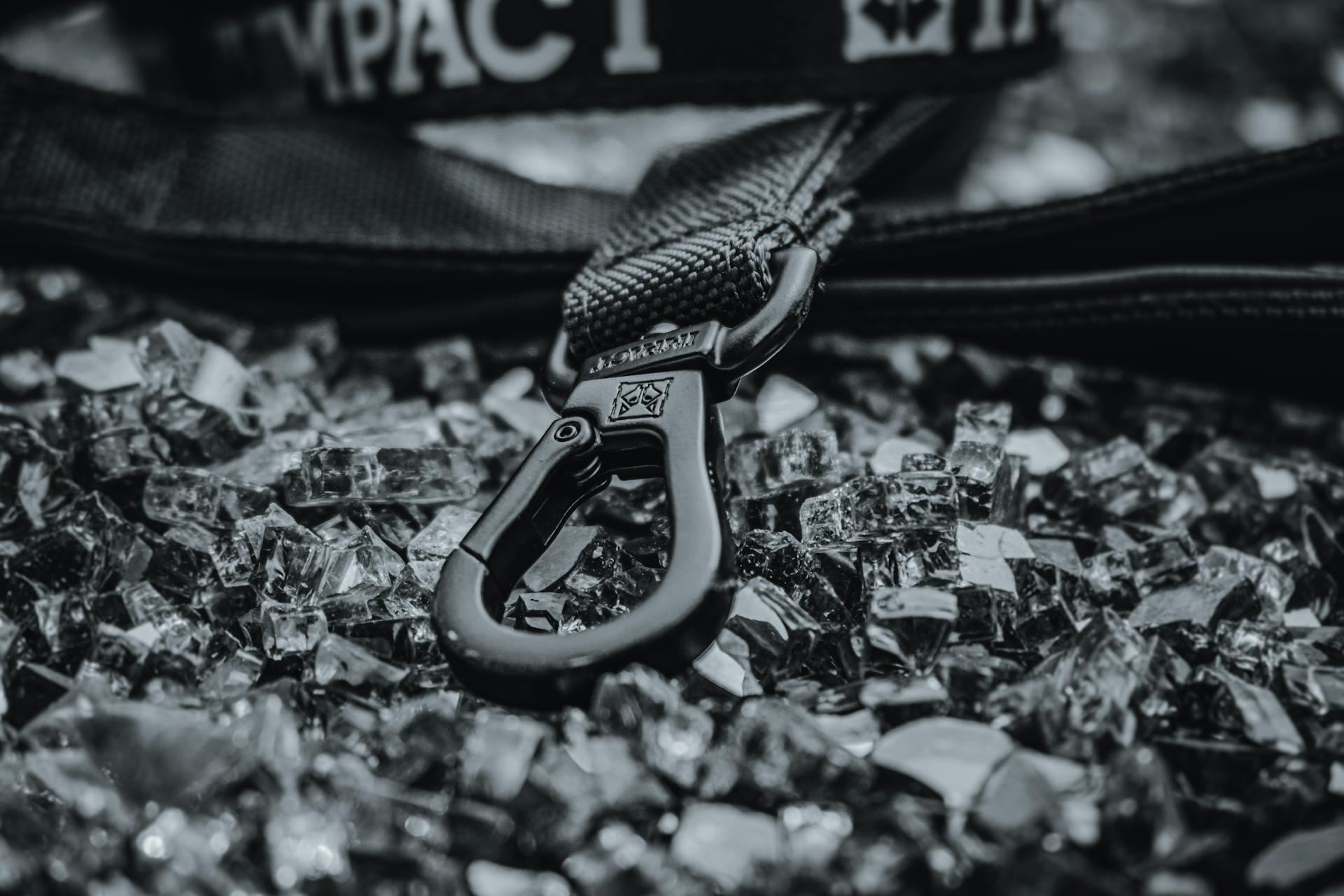
Crate training is a common practice for new dog owners, but some people question its ethics. Crate training can be beneficial for dogs, especially in the early stages of their life, as it helps with housetraining and reduces separation anxiety.
Dogs are den animals by nature, and they often seek out small, enclosed spaces to feel secure. Crate training taps into this natural instinct, providing a safe and comfortable space for dogs to retreat to when they feel overwhelmed.
However, some people believe that crate training is cruel, as it can be seen as confining or restrictive. But, in reality, crate training is not about depriving dogs of freedom, but rather about giving them a sense of security and stability.
For your interest: Crate Training vs Not
Getting Started
Crate training doesn't happen overnight, and introducing your dog to a crate should take place over a long period of time (several weeks or more).
It's essential to create a dog-safe environment for your dog to sleep in her crate but potty on an approved, easy-to-clean surface. This can be a small bathroom, kitchen, gated-off area of a room, or an ex-pen containing the dog's crate (with door removed), water, toys, and potty area.
Use your puppy's age in months plus one to determine the number of hours he can be crated. For example, if your puppy is 3 months old, he can hold his bowels and bladder for 4 hours.
Put the crate in an area of your house where you spend a lot of time, such as the family room or kitchen. This will help your dog feel more comfortable and secure in her crate.
Bring your dog over to the crate and talk to her in an excited, happy tone of voice. Make sure the door to the crate is securely fastened open so it won't accidentally hit your dog and frighten her.
Training My Dog
Crate training is a great way to help your dog feel safe and secure, but it's essential to do it right.
To start, introduce your dog to the crate gradually by dropping treats just inside the door. This will encourage them to enter the crate calmly. If they're not interested in food, try tossing a favorite toy inside instead.
The key is to make the crate a positive experience for your dog. You can start by feeding them regular meals near the crate, then gradually move the dish towards the back of the crate. This will help them associate the crate with pleasant experiences.
It's also crucial to ignore whining or crying while in the crate, especially if it's not due to distress or unmet needs. If you respond to whining, you may inadvertently reinforce the behavior.
Here are some things to avoid when crate training your dog:
- Don't rush the process. Crate training should be a gradual and gentle process.
- Don't yell or pound on the crate if your dog is whining. This will only make things worse.
- Don't give in to whining or bad behavior. This will reinforce the behavior and make it harder to train your dog.
- Don't use the crate as a punishment for bad behavior. This will associate the crate with negative experiences.
By following these tips and making the crate a positive experience for your dog, you can help them feel safe and secure.
Crating Basics
Crate training can take days or weeks, depending on your dog's age, temperament, and past experiences.
It's essential to approach crate training with patience and small, gradual steps to avoid setting your dog back and leading to fear and stress.
The Humane Society recommends consulting a veterinarian or professional dog trainer when considering crate training your dog.
To set your dog up for crate success, make the crate a cozy and quiet space with a comfortable bed, blankets, and favorite toys.
Leave the door open and the crate constantly accessible, so your dog feels free to come and go as they please.
Reward your dog with treats and praise when they enter the crate voluntarily, which can help create a positive association with the crate.
Curious to learn more? Check out: How Long Do Puppies Cry When Crate Training
Choosing a
Choosing a crate is a crucial step in crating your dog. Crates come in a variety of sizes and materials, with plastic and collapsible metal wire crates being the most common models.
For small breeds, plastic crates are often a great option since they're compact enough to use in the car. They can also be opened and used as snug, high-sided dog beds once your dog is fully housetrained.
Collapsible metal crates are often more practical for large breeds since they can be sectioned off into appropriately-sized spaces during housetraining. They're also easier to store when not in use.
It's essential to choose a crate that's of adequate size for your dog. This will ensure they have enough room to stand up, turn around, and lie down comfortably.
Some crates, like the Revol from Diggs, have a removeable bottom tray, which makes cleaning up after your dog a breeze. This is especially useful when traveling by air or dealing with messy dogs.
A different take: What Age to Start Crate Training
Setting Your Dog Up for Success
To set your dog up for success with crating, it's essential to make the crate a pleasant space. This can be achieved by placing treats or a favorite toy inside the crate to entice your dog to enter.
The crate should be cozy and quiet, located in a removed area of the house, and equipped with a comfortable bed, blankets, and any favorite toys. A crate with a comfortable bed can make all the difference in your dog's association with the crate.
Leave the door open and the crate constantly accessible so that your dog feels free to come and go as they please. This will help your dog feel comfortable and relaxed in the crate.
Here are some things to consider when setting up your dog's crate:
- Make the space as appealing and calm as possible
- Leave the door open and the crate accessible
- Place a comfortable bed, blankets, and favorite toys inside the crate
- Use verbal praise with soft, upbeat tones to make the experience positive
By following these tips, you can help your dog associate the crate with positive experiences and set them up for success with crating.
How Long Does It Take?
Crating Basics: How Long Does It Take?
Crate training can be accomplished in several days. The duration depends on your dog's age, temperament, and previous experiences.
Some dogs may pick up crate training quickly, while others may take longer. This can be influenced by factors such as age, with younger dogs potentially learning faster.
Crate training may take several weeks to achieve complete success.
Check this out: Crate Training Schedule by Age
Wire
Wire crates are a popular option for many dog owners, and for good reason - they're well-ventilated, lower profile, and durable.
However, it's worth noting that metal wire crates can be less portable than other options, especially for larger dogs.
A dog should be able to comfortably stand, sit, lay down, and turn around in their crate, so be sure to choose a size that fits your dog's needs.
Opt for a crate that will accommodate your dog's full adult size, and consider a crate that can be adjusted as your dog grows.
If the crate is too large, your dog may designate a far corner as a potty area, which isn't ideal.
Take a look at this: Cockapoo Size Crate
Common Issues
Some dogs have a habit of getting into trouble while left unsupervised, chewing on furniture and digging through the trash. These destructive behaviors cannot be addressed overnight.
A crate can be helpful in preventing home destruction while you are still in the midst of training. Ideally, your dog can eventually be trusted to stay at home alone.
Common Issues
Dogs can develop negative associations with their crate if it's used as a form of punishment. This can lead to severe stress and fear in your dog.

Crates should never be used to eliminate unwanted behaviors, such as digging through the garbage or chewing holes in your socks. Dedicated training is necessary to address these behaviors.
Dogs shouldn't spend excessive or extended periods of time in their crate. This can be boring, lonely, and restrictive for them.
Young puppies, especially those under six months of age, can't go without potty breaks and play sessions for more than three to four hours at a time.
Crates can be cruel and unsafe if left on a dog for too long.
Destructive Behavior
Destructive behavior is a common issue many dog owners face. Some dogs have a habit of getting into trouble while left unsupervised, chewing on furniture and digging through the trash.
A crate can be a helpful tool in preventing home destruction. Ideally, your dog can eventually be trusted to stay at home alone.
Destructive behaviors like these cannot be addressed overnight. It takes time and patience to train your dog to behave properly.
Frequently Asked Questions
Is crate training stressful for dogs?
Crate training can actually reduce stress and anxiety in dogs, providing a secure and comforting space. In fact, many dogs left out of crates are more anxious and stressed than those who have a crate to call their own.
Sources
- https://www.animalhumanesociety.org/resource/crate-training-your-dog-or-puppy
- https://moderndogmagazine.com/articles/a-trainers-truth-about-crates/
- https://emlabradors.com/2023/03/crate-training-why-it-works-and-why-its-not-mean/
- https://travelingleash.com/feeling-guilty-crating-dog-heres-shouldnt/
- https://www.ellevetsciences.com/news-old/the-truth-about-crate-training-your-dog/
Featured Images: pexels.com


